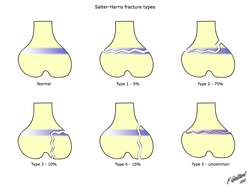Fractures
Other conditions to consider that may present as a hip fracture include: Osteogenesis Imperfecta, Slipped Capital Femoral Epiphysis, and Apophyseal Avulsion Injuries

- Trauma to the hip is much less common in infancy and early childhood than it is in later childhood and adolesencse.
- In younger children a Salter-Harris type I fracture, a fracture of the growth plate, are most common. femoral neck and intertrochanteric fractures are less common and stress fractures are quite rare. In older children and adolescents pelvic fractures and upper femoral avulsion fractures become more common. Most often associated with the avulsion fractures are the anterior-inferior and anterior- superior iliac spines along the inferior aspect of the ischium
Stress Fracture of the Femoral Neck
Stress fractures of the femoral neck are the result of repetitive microtrauma. In young people they are most often seen in armed forces recruits or track and field athletes. They are rare in children.
The athlete will usually present with complaints of persistent groin discomfort that is increased with activity. Physical examination may be unrevealing or demonstrate some pain with range of motion of the hip. Initial radiographs may be negative.
The athlete will usually present with complaints of persistent groin discomfort that is increased with activity. Physical examination may be unrevealing or demonstrate some pain with range of motion of the hip. Initial radiographs may be negative.
Pelvic Fracture
Acute pelvis fractures other than avulsion injuries are rare in the adolescent athlete as extreme violent trauma is usually required.
Fractures of the pelvis are classified into avulsion fracture, iliac wing fracture, simple stable ring fracture, and unstable ring fracture
Fractures of the pelvis are classified into avulsion fracture, iliac wing fracture, simple stable ring fracture, and unstable ring fracture
(8, 15)
